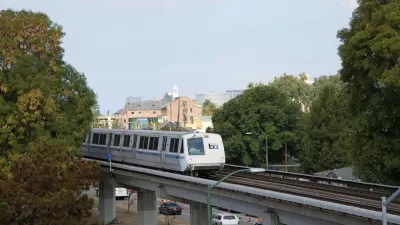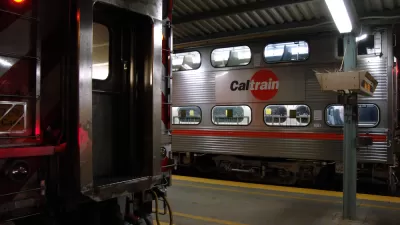The California Legislature approved bills to allow voters to decide on hiking sales taxes and tolls for regional transportation. Gov. Jerry Brown already signed a bill to allow San Mateo County voters to hike sales taxes for transportation.

Two bills on Gov. Jerry Brown's (D) desk to sign or veto by Oct. 15 would allow Bay Area voters to raise tolls and sales taxes for multi-county transportation purposes.
- SB 595 by Sen. Jim Beall (D-San Jose), also known as Regional Measure 3, would permit voters in all nine Bay Area counties to increase tolls by as much as $3 on the seven state-owned Bay Area toll bridges (Golden Gate Bridge is not state-owned), subject to a majority threshold for passage.
According to the Metropolitan Transportation Commission, sponsor of the bill, each $1 of toll increase generates about $125 million annually.
"The projects include everything from improved bridge approaches and increased ferry service across the bay to bringing BART to Silicon Valley," report Matier & Ross for the San Francisco Chronicle. "The wish list even includes money to start building an underground tunnel for [Caltrain] to come directly into downtown San Francisco."
- SB 797 by state Sen. Jerry Hill (D-San Mateo) if signed, "would authorize the Peninsula Corridor Joint Powers Board, which runs Caltrain, to place a one-eighth-cent sales tax on the ballot in San Francisco, San Mateo and Santa Clara counties." [Planetizen, June 26]. Subject to a two-thirds supermajority threshold for passage.
Gov. Brown has already signed AB 1613 by Assemblyman Kevin Mullin (D-South San Francisco), "thus enabling the San Mateo County Transit District [SamTrans] to seek a half-cent sales tax hike officials anticipate placing on the November 2018 ballot," reports Samantha Weigel for The Daily Journal. As with all sales tax measure that go for specific purposes, it would be subject to a two-thirds supermajority threshold for passage.
All three possible local ballot measures would appear after November 1, when SB 1's fuel taxes and registration fees take effect, hiking gas and diesel excise taxes by 12 cents and 20 cents per gallon, respectively, suggesting that the board members of the respectives agencies would have to consider "balancing voter fatigue with ballot timing," remarks Weigel.
Less than a year ago, Bay Area voters passed many local and regional ballot measures amounting to billions of dollars for transportation projects, including:
- Measure RR, $3.5 Billion BART Bond
- Measure C1, $600 Million AC Transit parcel tax extension
- Measure K, $1.6 Billion San Mateo County half-cent general sales tax extension that includes transit funding
- Measure B, $6.5 Billion Santa Clara County half-cent transportation sales tax measure
More good news for electric vehicles in California
Another transportation bill appearing on Brown's desk does not entail transportation funding nor ballot measures, but concerns those who drive electric vehicles (EVs), reports KQED News.
AB 544 by Assemblyman Richard Bloom (D-Santa Monica) would continue the Clean Air Vehicle decal program after Jan. 1, 2019 "to allow zero and near-zero emission vehicles to continue to qualify for carpool lane stickers in the Golden State." [Planetizen, July 10, 2017.] A budget bill to replenish the exhausted EV rebate program also awaits Brown's signature.
FULL STORY: aws providing county ways to seek transit tax

Trump Administration Could Effectively End Housing Voucher Program
Federal officials are eyeing major cuts to the Section 8 program that helps millions of low-income households pay rent.

Planetizen Federal Action Tracker
A weekly monitor of how Trump’s orders and actions are impacting planners and planning in America.

Ken Jennings Launches Transit Web Series
The Jeopardy champ wants you to ride public transit.

California Invests Additional $5M in Electric School Buses
The state wants to electrify all of its school bus fleets by 2035.

Austin Launches $2M Homelessness Prevention Fund
A new grant program from the city’s Homeless Strategy Office will fund rental assistance and supportive services.

Alabama School Forestry Initiative Brings Trees to Schoolyards
Trees can improve physical and mental health for students and commnity members.
Urban Design for Planners 1: Software Tools
This six-course series explores essential urban design concepts using open source software and equips planners with the tools they need to participate fully in the urban design process.
Planning for Universal Design
Learn the tools for implementing Universal Design in planning regulations.
Ada County Highway District
Clanton & Associates, Inc.
Jessamine County Fiscal Court
Institute for Housing and Urban Development Studies (IHS)
City of Grandview
Harvard GSD Executive Education
Toledo-Lucas County Plan Commissions
Salt Lake City
NYU Wagner Graduate School of Public Service




























